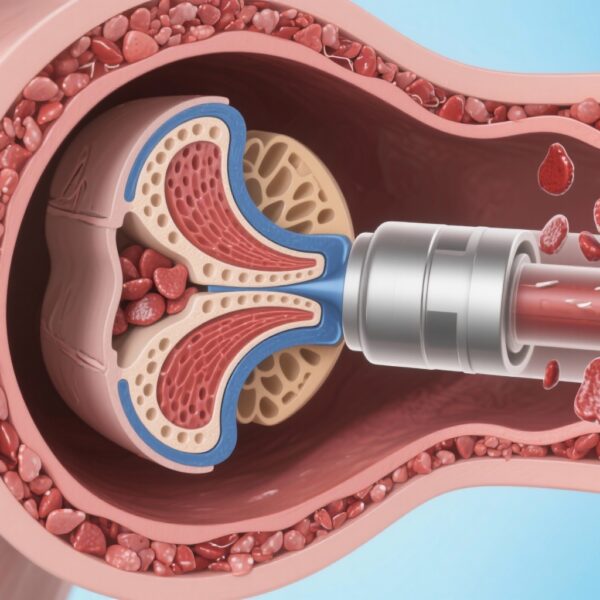Highlight
- Azacitidine, a hypomethylating agent traditionally used in myelodysplastic syndrome (MDS), demonstrates significant efficacy in reducing inflammation and cytopenias in VEXAS syndrome patients.
- Over 60% of patients achieved inflammatory response with notable hematologic improvements, and a majority showed molecular evidence of reduced UBA1 mutant clone burden.
- Relapse rates were low during continued azacitidine therapy, and re-exposure to azacitidine was effective in most cases after relapse upon discontinuation.
- Adverse events such as infections and cytopenias were common but predominantly occurred early in treatment, indicating an acceptable and manageable safety profile.
Study Background
VEXAS syndrome (vacuoles, E1 enzyme, X-linked, autoinflammatory, somatic) is a recently characterized monogenic autoinflammatory disorder caused by somatic mutations in the UBA1 gene. It manifests with systemic inflammation, cytopenias, and frequently overlaps with myelodysplastic syndromes (MDS). The disease typically affects adult males and is associated with substantial morbidity, including steroid dependence and complications related to persistent inflammation and cytopenias.
There is a high unmet medical need for effective treatment options. While steroids provide temporary control, they are associated with significant long-term toxicity and relapse. Targeted therapies have exhibited limited efficacy to date. Given the overlap of VEXAS with MDS and the central role of clonal hematopoiesis, hypomethylating agents (HMAs) such as azacitidine have been hypothesized to offer benefit by reducing mutant clone burden and alleviating systemic inflammation.
Study Design
This multicenter retrospective study conducted by the French VEXAS study group (FRENVEX) included 88 patients with genetically confirmed VEXAS syndrome, of whom 80% fulfilled World Health Organization (WHO) 2022 criteria for MDS diagnosis. The study evaluated the efficacy and safety of azacitidine (AZA) treatment. Patients were treated according to local protocols and followed longitudinally to assess inflammatory and hematological outcomes, molecular response based on UBA1 variant allele frequency (VAF), and adverse events.
The primary assessments included inflammatory response—defined by resolution or significant improvement of inflammatory symptoms—and hematological response, including red blood cell transfusion independence and platelet improvements. Molecular response was evaluated by at least a 25% reduction in UBA1 VAF. Safety endpoints captured the incidence and timing of infections and cytopenias.
Key Findings
Inflammatory Response: At 6 months, 41% of patients showed a positive inflammatory response, increasing to 54% at 12 months, indicating a delayed but meaningful therapeutic effect. Overall, 61% achieved an inflammatory response during follow-up, with 70% of these responders identified within the first 6 months of treatment. This suggests a progressive improvement with prolonged azacitidine therapy.
Hematological Outcomes: Among treated patients, 65% achieved red blood cell transfusion independence, while 77% demonstrated platelet count improvements, underscoring azacitidine’s dual efficacy in addressing cytopenias that characterize VEXAS syndrome and associated MDS.
Molecular Response: A reduction of ≥25% in UBA1 mutant VAF was observed in 65% of patients. Importantly, all patients with this molecular response also attained inflammatory and hematological improvements. In 43% of cases, VAF decreased to below 2%, suggesting substantial suppression of the pathogenic clone.
Relapse and Long-term Outcomes: Among responders, relapse-free survival on continued azacitidine therapy was high—90% at 1 year and 85% at 5 years. Of 12 responders who discontinued treatment, 9 experienced relapse after a median of 3.1 years, highlighting the potential need for ongoing therapy. Re-challenge with azacitidine was effective in 4 of 5 patients who underwent re-exposure, indicating durable response potential upon retreatment.
Safety Profile: Adverse events were consistent with known azacitidine toxicities. Infections occurred in 34%, and cytopenias in 36%, predominantly within the first three treatment cycles. These side effects were manageable with close monitoring and supportive care.
Expert Commentary
This large retrospective cohort provides compelling evidence that azacitidine addresses multiple pathogenic facets of VEXAS syndrome—systemic inflammation, cytopenias, and clonal hematopoiesis. The correlation between molecular response and clinical improvement offers important biological plausibility that targeting the UBA1 clone can mitigate disease manifestations.
While the retrospective design and heterogeneity in treatment initiation and monitoring pose limitations, the outcomes justify prospective, controlled studies to optimize dosing, duration, and patient selection. Additionally, long-term safety and strategies to manage relapse after treatment cessation require further elucidation.
Given the limited efficacy of conventional therapies and the severe morbidity associated with VEXAS syndrome, azacitidine represents a promising therapeutic advance with potential to fill a critical gap in clinical management.
Conclusion
Azacitidine demonstrates efficacy in improving inflammatory symptoms, hematological parameters, and reducing UBA1 mutant clone burden in VEXAS syndrome patients, including those with concomitant MDS. The treatment is generally well tolerated, with manageable adverse events largely confined to early treatment phases. These findings support incorporation of azacitidine into therapeutic strategies for VEXAS syndrome and underscore the need for larger prospective trials to validate optimal use.
Funding and ClinicalTrials.gov
The FRENVEX study group conducted this retrospective analysis; funding sources and clinical trial registration were not specified in the published report.
References
Jachiet V, Kosmider O, Beydon M, et al. Efficacy and safety of azacitidine for VEXAS syndrome: a large-scale retrospective study from FRENVEX. Blood. 2025 Sep 18;146(12):1450-1461. doi: 10.1182/blood.2024028133. PMID: 40373272.



